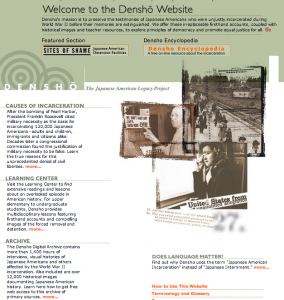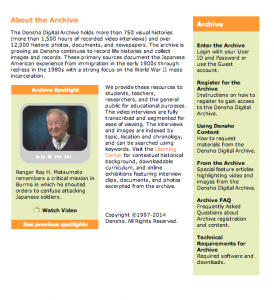by Ann Matsushima Chiu
Densho was first introduced to me while working on the book project “Speaking Out for Personal Justice: Site Summaries of Testimonies and Witnesses Registry from the U.S. Commission of Wartime Relocation and Internment of Civilians Hearings (CWRIC),1981,” published by the UCLA Asian American Studies Center. It was my introduction to library and archival work, and subsequent involvement with the preservation of Japanese American historical materials. Densho is a wonderful reference in my current digital archives internship at the Oregon Nikkei Legacy Center in Portland, Ore. It is our hope that you explore this rich digital archive of Japanese American wartime incarceration and history.
APALA would like to thank Geoff Froh and Brian Niiya from Densho for their time and willingness to participate in this interview. The following article presents a version of our interview that has been edited for clarity and brevity. Geoff Froh, Deputy Director for Densho, and Brian Niiiya, Content Director for Densho and Editor of the Densho Encyclopedia, both provided answers to my interview questions.

Ann Matsushima Chiu (AMC): How did Densho as a nonprofit organization come about? Where does Densho’s content come from?
Densho began in 1996 with the idea of interviewing Japanese Americans about their World War II concentration camp experience “to educate, preserve, collaborate and inspire action for equity.” Inspired in part by the Survivors of the Shoah Project, a Steven Spielberg-led endeavor to record the testimony of Holocaust survivors on video, Densho’s founders recognized that with the advent of personal computers, digital video, and the Internet, the collection, preservation, and distribution of high quality video life histories could now be accomplished for a fraction of the cost. Densho decided early on that it would make its materials available without charge for anyone using them for educational purposes and that it would house no physical collection that the digital files offered on its website would be its main “product.” In conducting its interviews, Densho found that many interview subjects also had photographs or documents that added to the stories they told. Densho added digital images of these items to the website, and began to seek out additional similar objects from both individuals and families and from institutions to add to its digital archive. In addition, Densho has a good deal of public domain material from various governmental archives. In recent years, Densho has included to its archive full interviews conducted by makers of documentary films about the wartime incarceration. Densho has also actively sought mutually beneficial collaborations with collecting institutions that allow important material that had been buried in archives to reach much larger audience through Densho’s online archives.
AMC: Amongst the many collections, such as the Visual History Collection, Photo/Document Collection, Oral Histories and Incarceration Camp Facilities, one of the archives that caught our eye was the Camp Newspapers Collection created by Japanese Americans in incarceration camps during World War II. It is interesting to have such rare digital objects of this nature available to the public.Could you share any interesting research that has come about through the availability of Densho’s collections? What are the rules for reuse and publication of digital images on Densho.org?
Densho is well established among scholars of the Japanese American World War II experience, and it would not be an exaggeration to say that most recent scholarship on this general topic has made use of Densho’s resources, including such important recent books as Greg Robinson’s “After Camp: Portraits in Midcentury Japanese American Life and Politics” (Berkeley: University of California Press, 2012); Gordon K. Hirabayashi with James A. Hirabayashi and Lane Ryo Hirabayashi’s “A Principled Stand: The Story of Hirabayashi v. United States” (Seattle: University of Washington Press, 2013), Eileen Tamura’s “In Defense of Justice: Joseph Kurihara and the Japanese American Struggle for Equality” (Urbana: University of Illinois Press, 2013), and Ellen Wu’s “The Color of Success: Asian Americans and the Origins of the Model Minority” (Princeton: Princeton University Press, 2014). Many graduate theses and students’ assignments make use of Densho resources as well. Densho holds a strong belief that the responsibility of an archival institution begins with preservation; but must extend to the active use of its holdings. Core to Densho’s strategy for encouraging the dissemination of its materials is a simple framework for licensing and reuse. The majority of oral histories conducted by Densho, along with many of the digital photos and objects in its collections are offered under a Creative Commons Attribution-NonCommercial-ShareAlike 4.0 International License. This grants the right to freely reuse and remix Densho’s content as long as it is properly cited and for noncommercial purposes (see: http://creativecommons.org/licenses/by-nc-sa/4.0/). For many of the other digital objects in its collections not covered under Creative Commons, Densho has secured the rights to grant license for other educational projects. The most current information about using Densho content and licensing is available at: http://www.densho.org/default.asp?path=/archive/usingcontent.asp and http://ddr.densho.org/using/.

AMC: What are some unique characteristics of Densho that API information professionals would especially be interested in?
One Densho resource that would be of interest is the Densho Encyclopedia. A free, professionally edited, online encyclopedia that includes contributions from many of the leading scholars of the Japanese American experience, the encyclopedia is aimed at nonspecialists looking for concise information on that experience. Encyclopedia articles include citations and references readers may consult for further information as well as links to selected Densho resources relevant to that topic. The encyclopedia would be useful for information professionals in fielding reference requests, writing or updating finding aids for archival collections, or determining which book or videos on the incarceration experience to purchase, among many other uses.
AMC: Are there any education projects or community collaborations that Densho would highlight in particular?
Densho’s education efforts in recent years have centered on a program of workshops that trains high school teachers across the country to use Densho’s digital resources to teach not only about the wartime incarceration, but about larger issues of civil liberties in wartime. The most recent project involved 625 teachers from 22 states. Recognizing that even that number of teachers can reach only a fraction of the students in the country, Densho is currently working on an online version of the teacher workshops.
With regards to collaborations, Densho is involved in formal partnerships with several community organizations including the Heart Mountain Interpretive Center, the Japanese American Museum of San Jose, the Japanese American National Museum, the Japanese Cultural Center of Hawai’i, Oregon Nikkei Endowment, and the Hawai’i Times Photographic Archive Foundation. In each case, Densho is working with the institution to digitize objects in their collections to add to the Densho Digital Repository. Densho collaborates with many other organizations informally.
AMC: What message would you give to librarians/archivists regarding their value to digital collections like Densho? How would Densho like to engage future APA information professionals?
Densho would like to continue to build partnerships with institutions that collect materials about the Japanese American World War II experience and is interested in hearing from information professionals who manage these collections, whether about possible collaboration or about the common issues we face. In an era when so many turn to the Internet for research, Densho is committed to building the best online resource in our topic area, and we’d like to be as inclusive and open as we can.
For more information on “Speaking Out for Personal Justice: Site Summaries of Testimonies and Witnesses Registry from the U.S. Commission of Wartime Relocation and Internment of Civilians Hearings (CWRIC),1981,” visit http://www.speakingoutforpersonaljustice.com.
Editorial assistance provided by Jeremiah Paschke-Wood.

